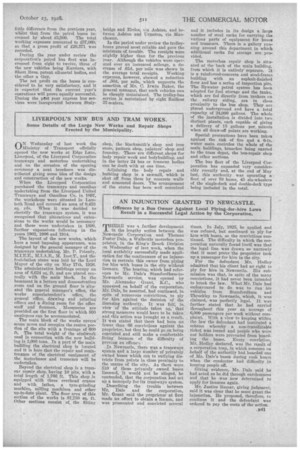LIVERPOOL'S NEW BUS AND TRAM WORKS.
Page 25

If you've noticed an error in this article please click here to report it so we can fix it.
Some Details of the Large New Works and Repair Shops Erected by the Municipality.
OrIN Wednesday of last week tho of Transport officially opened the new works at Edge Lane, Liverpool, of the Liverpool Corporation tramways and motorbus undertaking and on the occasion of the opening ceremony a neat brochure was distributed giving some idea of the design and construction of the new works.
' When the Liverpool Corporation purchased the tramways and omnibus undertaking from the Liverpool United Tramways and Omnibus Co. in 1897, the workshops were situated in Lambeth Road and covered an area of 0,453 sq. yds. When it was decided to electrify the tramways system, it was recognized that alterations and extensions to the works would be necessary and these were undertaken in 1899, further expansions following in the years 1902, 1906 and 1914.
The layout of the new works, which have a most imposing appearance, was designed by the general manager of the tramways undertaking, Mr. P. Priestly, M.I.E.E., 141.1.A.E., M. Inst.T., and the foundation stone was laid by the Lord Mayor of the city on May 17th, 1926. The administrative buildings occupy an area of 6,624 sq. ft. and are placed centrally with the main block. In no basement is a lecture and demonstration room and on the ground floor is situated the general manager's office, the works superintendent's office, the general office, drawing and printing offices and a dining room for the office staff and foremen. . IN.:lessee:ems are provided.on the Rest floor in which 800 employees can be accommodated.
The main block of the works covers seven acres and occupies the centre portion of the site with a frontage of 600 ft. The total weight of the steelwork used in connection with the new building is 3,000 tons. In a part of the main building the electrical shop is located and it is here that the repair and maintenance of the electrical equipment of the Motorbuses and tramcars will be
undertaken. •
Beyond the electrical shop is a tramcar repair shop, having 10 pits, with a total length of 1,766 ft. This shop is equipped with three overhead cranes and with lathes, a tyre-grinding machine, milling machines and other up-to-date plant. The floor area of this section of the .works is 87,750 sq. ft. Other sections consist of, the fitting shop, the blacksmith's shop and iron store, pattern shop, painters' shop and foundry. There are different shops for body repair work and bodybuilding, and in the latter 24 bus or tramcar bodies can he dealt with at one time.
Adjoining the body repair and building shop is a sawmill, which is shut off from them by concrete walls and armoured doors. The arrangement of the stores has been well conceived
and it includes in its design a large number of steel racks for carrying, the various parts of equipment for buses and tramcars. There is a gallery running around this department in which additional racks for storage are presided.
The motorbus repair shop is situated at the back of the main building,
from which it is entirely separate.1.-t is a reinforced-concrete and steel-frame
building with an asphalt-finished floor and has a series of inspection pits. The Bywater petrol system has been adopted for fuel storage and the tanks, which are fed directly from tankers en the railway siding, are in close proximity to the bus shop. They aro placed underground and have a total capacity of 24,000 gallons. The whole of the installation is divided into two distinct plants, each capable of giving a delivery of 15 gallons per minute when all draw-off points are working.
Special precautions have been taken against the risk of fire and a 6-in.
water main encircles the NtIole of the main buildings, branches being carried to the tram depot, the bus-repair shop and other sections. '
The bus fleet of the Liverpool Corporation has expanded very consider ably recently and, at the end of May last, this anthority was operating a fleet of over 70 buses, 45 six-wheelers of the single-deck and double-deck type being included in the total.


































